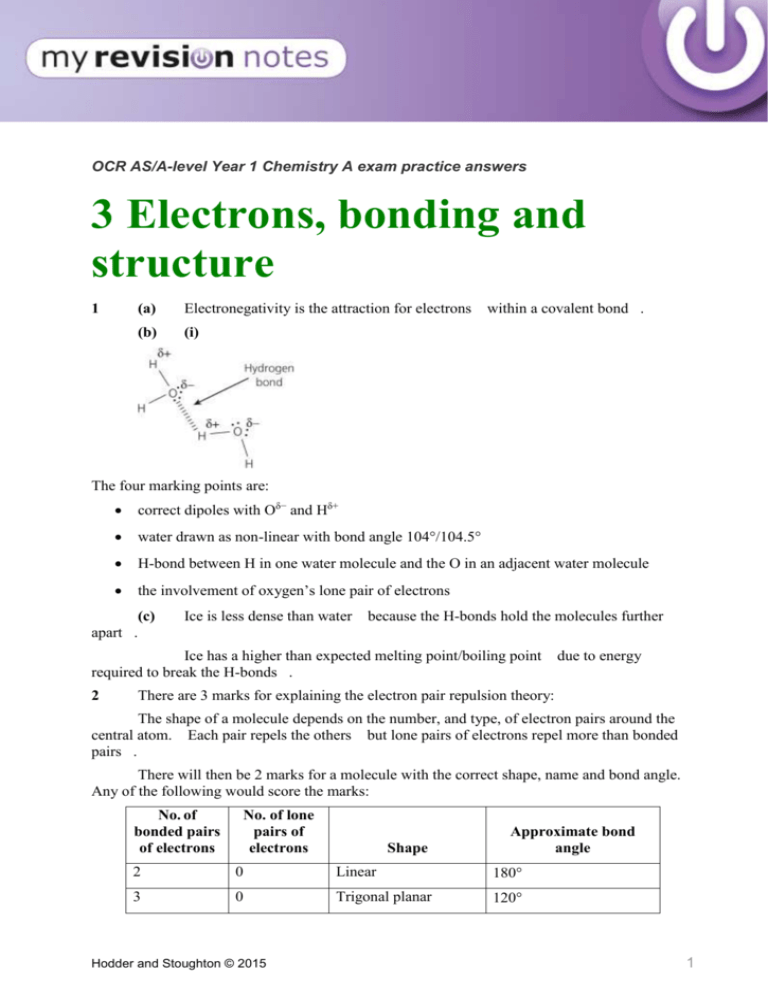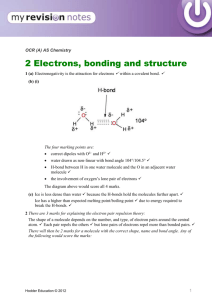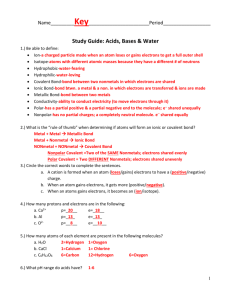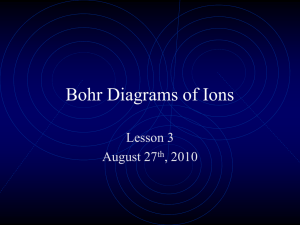Exam practice answers
advertisement

OCR AS/A-level Year 1 Chemistry A exam practice answers 3 Electrons, bonding and structure 1 (a) Electronegativity is the attraction for electrons (b) (i) within a covalent bond . The four marking points are: correct dipoles with Oδ− and Hδ+ water drawn as non-linear with bond angle 104/104.5 H-bond between H in one water molecule and the O in an adjacent water molecule the involvement of oxygen’s lone pair of electrons (c) Ice is less dense than water because the H-bonds hold the molecules further apart . Ice has a higher than expected melting point/boiling point required to break the H-bonds . 2 due to energy There are 3 marks for explaining the electron pair repulsion theory: The shape of a molecule depends on the number, and type, of electron pairs around the central atom. Each pair repels the others but lone pairs of electrons repel more than bonded pairs . There will then be 2 marks for a molecule with the correct shape, name and bond angle. Any of the following would score the marks: No. of bonded pairs of electrons No. of lone pairs of electrons Shape Approximate bond angle 2 0 Linear 180 3 0 Trigonal planar 120 Hodder and Stoughton © 2015 1 3 4 0 Tetrahedral 109.5 6 0 Octahedral 90 3 1 Pyramidal 107 2 2 Angular 104 Marking points for MgO: ionic lattice strong bonds throughout requires high energy to break these bonds/melt MgO* Marking points for SO2: covalent polar weak intermolecular forces/dipole–dipole/van der Waals requires low energy to break these bonds/melt SO2* (*Only award the mark for one statement as to the amount of energy required.) When attempting free response questions, it is essential that you have a plan, which should be based on the information given in the question. There are 6 marks available and it is safe to assume that the examiner will split these marks between the two substances, so it would be sensible to try to give three distinct points for each substance, as follows: MgO has a giant ionic lattice with strong bonds throughout, hence it needs lots of energy to melt. Hodder and Stoughton © 2015 2 4 SO2 has polar covalent molecules with weak intermolecular forces between the molecules, hence it needs little energy to melt. (a) The marks would be distributed as follows: Na: lattice of positive ions delocalised electrons ; the metallic bond is the attraction between the positive ions in the lattice and the delocalised electrons Cl2: covalent NaCl: ionic lattice (b) sharing electrons electrostatic attraction between oppositely charged ions Cl2: two properties which forms a giant two reasons to explain the properties Gas/low boiling point because weak intermolecular forces between the molecules. Poor conductor because no mobile charge carriers (electrons or ions). NaCl: two properties ; two reasons to explain the properties Solid/high boiling point because strong forces throughout the giant lattice. Poor conductor when solid but conducts when molten/aqueous because ions are not free to move when solid but can move when aqueous or molten. Soluble in water/polar solvents because ions are attracted to the dipoles in water/polar solvents. Students often find free response questions difficult to answer. There are always clues within the question. In (b) you are given two substances — Cl2 and NaCl — and asked to 'relate the physical properties to their structure and bonding'. There are 8 marks for this and it is, therefore, Hodder and Stoughton © 2015 3 logical to give two properties for each, along with an explanation of each of those properties — i.e. 8 different points for 8 marks. Chemists communicate in lots of different ways and it is perfectly acceptable to tabulate your answers as shown below: (a) Sodium Chlorine Sodium chloride Metallic bonding Covalent bonding Ionic bonding A giant lattice of positive ions surrounded by delocalised electrons There is a shared pair of electrons in the bond Electrostatic attraction between oppositely charged ions (b) Cl2 NaCl Property Reason Gas/low boiling point Weak intermolecular forces between the molecules Poor conductor No mobile charge carriers (electrons or ions) Solid/high boiling point Strong forces throughout the giant lattice Poor conductor when solid but conducts when molten/aqueous Ions are not free to move when solid but can move when aqueous or molten Soluble in water/polar Ions are attracted to the dipoles in water/polar solvents Hodder and Stoughton © 2015 4







